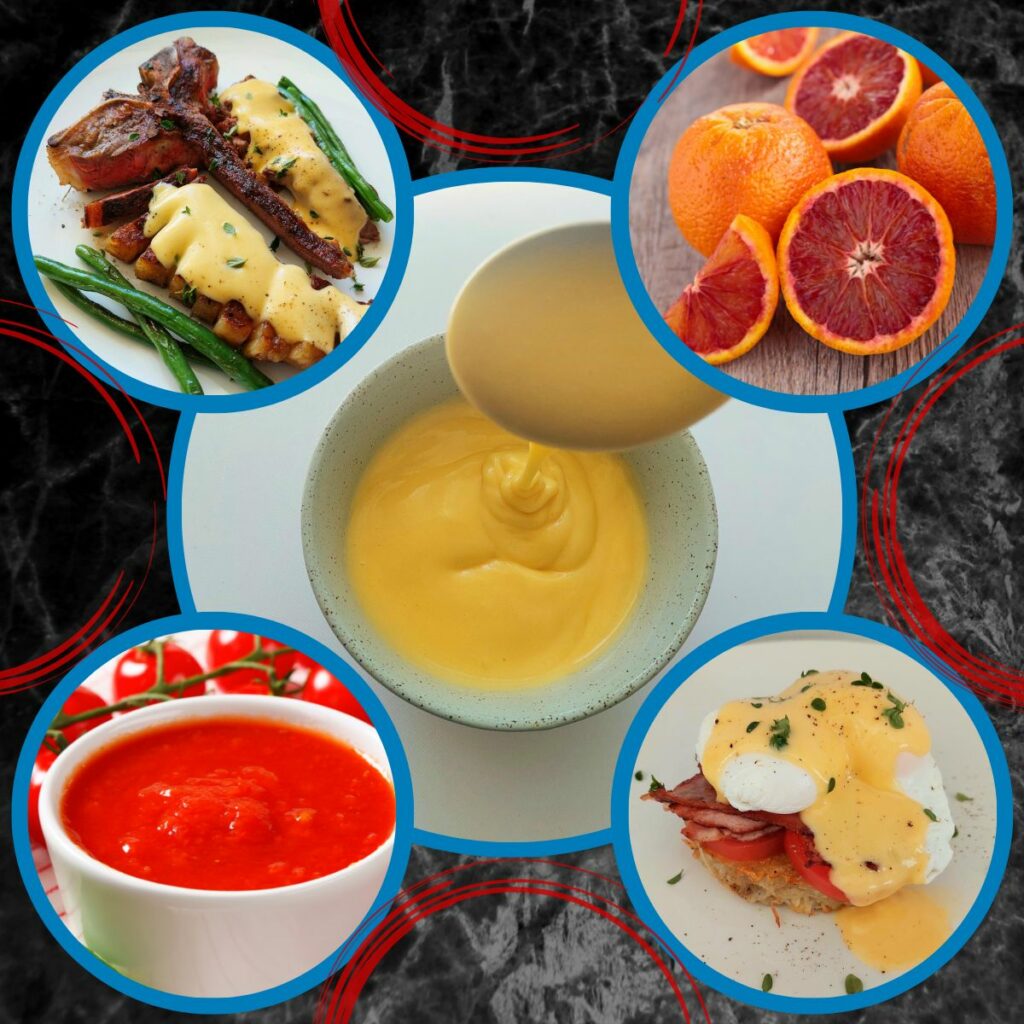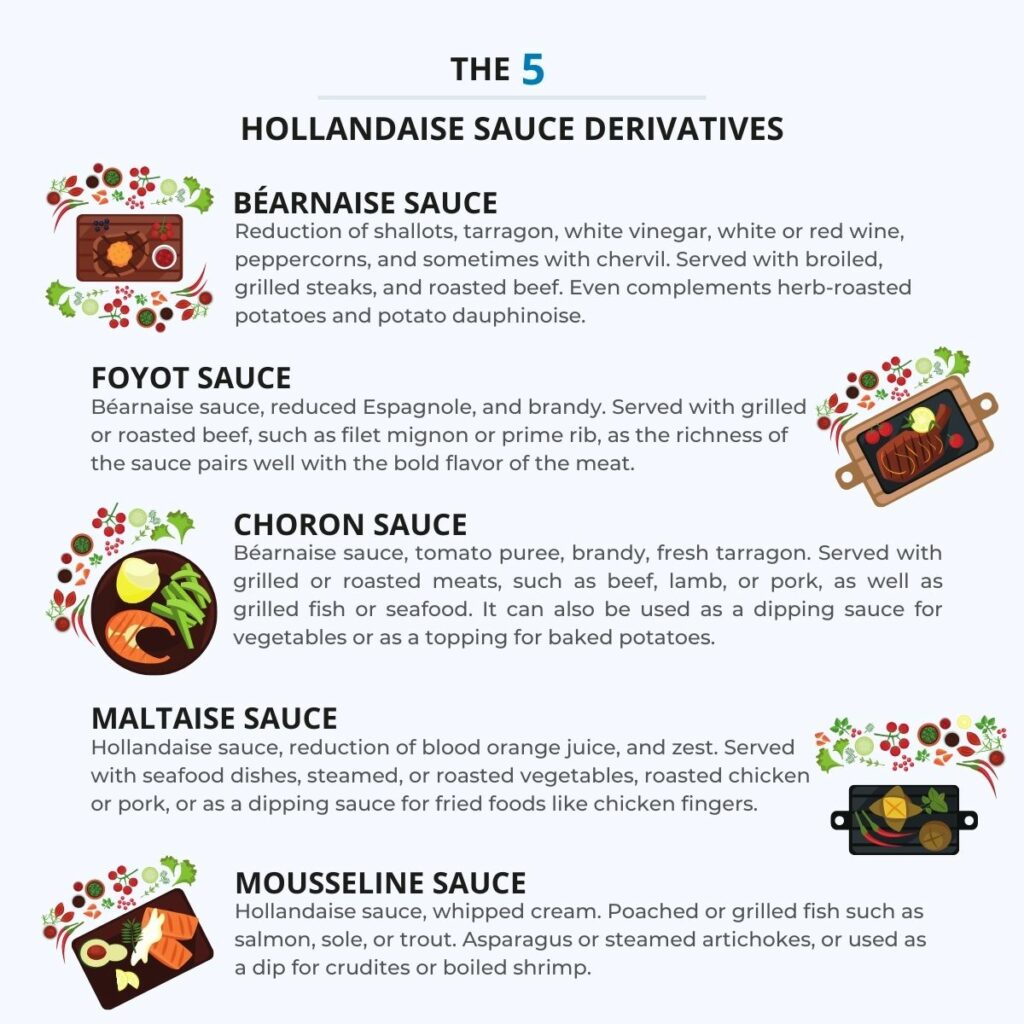Privacy Policy | Terms and Conditions | Disclosure Statement | License Policy
COPYRIGHT © 2024 | NUMBER 8 COOKING | ALL RIGHTS RESERVED.

Privacy Policy | Terms and Conditions | Disclosure Statement | License Policy
COPYRIGHT © 2024 | NUMBER 8 COOKING | ALL RIGHTS RESERVED.

Privacy Policy | Terms and Conditions | Disclosure Statement | License Policy
COPYRIGHT © 2024 | NUMBER 8 COOKING | ALL RIGHTS RESERVED.
Hollandaise sauce derivatives are variations of the classic French sauce hollandaise. The sauce is used for the famous breakfast eggs benedict. Hollandaise is one of the 5 mother sauces. that’s a favorite among chefs and food enthusiasts alike.
This rich and velvety emulsion sauce is made from egg yolks, butter, and a reduction of white vinegar, white wine, peppercorns, bay leaves, and thyme. It’s often used to accompany eggs, fish, and vegetables like asparagus, and baby carrots.
But did you know that Hollandaise sauce has given rise to many flavorsome mother sauce derivatives that are equally as delicious and versatile?
In this blog post, we’ll explore 5 Hollandaise sauce derivatives, each with its unique flavor profile and culinary applications.
From the tangy and herbaceous Béarnaise sauce to the velvety and creamy Mousseline sauce. Each derivative adds a new dimension of flavor and texture to dishes.
We’ll also delve into the savory and rich Foyot sauce. The tangy and slightly sweet Choron sauce, and the citrusy and zesty Maltaise sauce.

Whether you’re a home cook looking to add to your sauce-cooking repertoire. Or a professional chef looking for inspiration and innovative sauce ideas.
These Hollandaise sauce derivatives are sure to help. So grab your apron, fire up your stove, and let’s get cooking!
As a skilled professional chef, I’m excited to share these delicious and versatile sauces with you.
How to season food is an art that combines creativity, intuition, and a deep understanding of flavors. That transforms ordinary ingredients into extraordinary culinary masterpieces.
Maltaise sauce is a delightful derivative of the classic Hollandaise sauce. It’s made by adding freshly squeezed reduced blood orange juice to the Hollandaise sauce.
This gives the sauce a citrusy and slightly sweet flavor profile. This sauce is perfect for elevating seafood dishes, steamed, or roasted vegetables, and roasted chicken, or pork.
Or as a dipping sauce for fried foods like chicken fingers. Excellent with asparagus or broccoli.
Chefs Pro Tip — Incorporating hot ingredients into hollandaise sauce after it’s made will result in a broken sauce.
When the hollandaise sauce splits, the butter separates from the eggs, ruining its smooth and velvety texture.
Therefore, it’s crucial to cool any additional ingredients you add when making Hollandaise sauce derivatives.
Luxurious Mousseline sauce, a Hollandaise derivative that boasts a rich and creamy flavor. The addition of whipped cream gives it an airy texture.
Mousseline sauce complements delicate foods such as Poached or grilled fish like salmon, sole, or trout. Great to serve with asparagus or steamed artichokes, or used as a dip for crudites or boiled shrimp.
This sauce is the ultimate indulgence and will complement your next fish recipe. The addition of cream makes it a light, creamy, rich sauce.
Chefs Pro Tip — When folding the whipped cream into the Hollandaise sauce use a large metal spoon. Also known as a chef’s spoon.
Fold the cream in, don’t whisk, or stir it in as the cream will lose its body and the sauce will become thick and heavy.

Béarnaise sauce is a classic French sauce that never fails to impress. This velvety smooth emulsion sauce is perfect for pairing with broiled, grilled steaks, and roasted beef. Even complements herb-roasted root vegetables and potato dauphinoise.
Béarnaise sauce is buttery, rich, tangy, and herbaceous all at the same time. It’s a sauce we make every day in the kitchen, and it’s served with seared tenderloin, potato, and bacon gratin.
Chefs Pro Tip — The difference between hollandaise and béarnaise is the reduction. Replacing the thyme with tarragon, you can also use red wine instead of white wine. Giving the finished sauce a slightly dark color and more intense flavor.
Foyot sauce is a classic French sauce that’s similar to Béarnaise sauce but with the addition of meat glaze (reduced Espagnole) giving it a meaty, savory flavor.
This sauce is perfect for adding depth and complexity to grilled or roasted beef, such as filet mignon or prime rib. As the richness of the sauce pairs well with the bold flavors of the meat. Its rich flavor profile makes it a favorite among meat lovers.
This sauce is not as well-known as some of its counterparts but is just as delicious. Its unique flavor profile sets it apart from other sauces.
Chefs Pro Tip — Add the reduced Espagnole to the bearnaise sauce when it is warm. If you add the Espagnole when it is hot it will split the bearnaise sauce.
When cooling the Espagnole sauce, cover it with a cartouche or plastic wrap. This will prevent it from forming a skin. When whisked, the skin will make the sauce lumpy.
Choron sauce is a classic derivative of Béarnaise sauce. With the addition of tomato puree, brandy, and fresh tarragon. This sauce is tangy, herbaceous, and has a slightly sweet flavor profile.
It pairs well with broiled or roasted meats, such as beef, lamb, or pork, as well as grilled fish or seafood. It can also be used as a dipping sauce for vegetables or as a topping for baked potatoes.
It’s a perfect accompaniment to any dish that needs a little bit of zing. Choron sauce is perfect for adding a touch of sophistication to any dish.
Chefs Pro Tip — Add the fresh tarragon at the end after reducing the tomato puree. This subtle addition will give your sauce a burst of bright, fresh flavors.
Replace the tomato puree with one of the tomato sauce derivatives. This will give the Choron sauce a complex flavor and texture.
The delicate notes of the tarragon will create a herbaceous aroma and enhance the overall taste of the finished sauce.
A hollandaise sauce derivative is where other ingredients are added to Hollandaise to make a new sauce.
This becomes a derivative sauce, which is a variation of the mother sauce Hollandaise.
These Hollandaise sauce derivatives retain the rich and creamy texture of the original sauce while adding a unique flavor profile.
Hollandaise sauce derivatives are not difficult to make. While they require some skill and attention to detail. By following the proper techniques and recipe instructions. You can create a delicious and impressive sauce, that will complement any dish you serve it with.
The difference between Hollandaise and Béarnaise is the flavor.
The main difference is Béarnaise sauce is flavored with a tarragon reduction and sometimes chervil.
Whereas Hollandaise sauce is typically flavored with a thyme reduction and sometimes lemon juice.
Hollandaise is a versatile sauce that has given rise to many delicious derivatives. Each with its unique flavor and culinary applications.
From the tangy and herbaceous Béarnaise sauce to the velvety and creamy Mousseline sauce. Each derivative adds a new dimension of flavors and textures to dishes.
The savory and meaty Foyot sauce and the tangy and slightly sweet Choron sauce with its piquant tomato and tarragon flavors. Perfect for adding depth and complexity to dishes.
And let’s not forget the Maltaise sauce, with its citrusy and zesty flavor profile that’s perfect for pairing with seafood and vegetables.
As a skilled professional chef, I encourage you to try these delicious Hollandaise sauce derivatives and experiment with them in your kitchen.
Whether you’re a home cook or a professional chef. These Hollandaise sauce derivatives are sure to inspire you to start experimenting with unique and bold flavors.